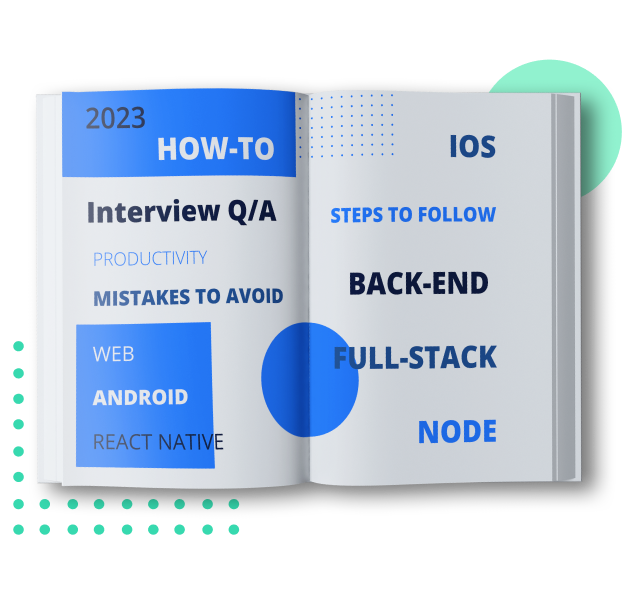The responsibility of designers and front-end developers is to make an app visually pleasing, but there is a lot of work happening behind the scenes as well. The application or product won’t function or process any data that users enter unless back-end developers keep under-the-hood components on track.
Even if you don’t fully understand how solutions work, it’s clear that the “back end” of an app aggregates technology and advanced programming into one complicated and continuous process.
Back-end specialists support product components that are never revealed to an end-user – viz. servers, applications, and last but not least, databases. To put it simply, a back-end developer is a person who is in charge of building and maintaining the technology and ensures all components that are displayed on the user interface perform their intended functions. The code produced by a back-end developer allows everything that a front-end developer creates to work correctly.
Even though back-end development is not incredibly popular among aspiring programmers due to many factors (mainly the complexity of programming languages, e.g., Java), the number of back-end developers continues to grow.
In this article, we will shed some light on the most crucial things you need to know, before hiring back-end developers.
Back-End developer responsibilities
Back-end developers work side-by-side with front-end developers, full-stack developers, and UX specialists. The common goal is to create the most comprehensive technology solutions for businesses of any kind. The main task of a back-end developer is to ensure that the app they are responsible for will withstand large loads of traffic and not crash, even with highly demanding scripts.
Furthermore, back-end programmers answer for such vital things as maintenance and continuous testing of the app’s existing back-end elements. The latter ensures that all the components are working fast and efficiently, without any interruptions or bugs. Back-end developers also control data storage. Their area of expertise also includes a solid knowledge of data security and compliance terms.
Typical responsibilities of a back-end developer include:
- Creating and maintaining various web applications;
- Developing, integrating, and managing databases;
- Integrating cloud computing solutions;
- Integrating third-party APIs;
- Preventing security problems and attacks;
- Collecting, generating, and analyzing statistics;
- Ensuring top-notch efficiency and speed in applications under their control;
- High-quality coding;
- Working with hosting environments;
- Problem-solving, such as troubleshooting or debugging.
Essential skills a Back-End developer must have
Now that you know what back-end development is and what it involves, the responsibilities that we described in the section above can be categorized into two types of skills – hard and soft. Great back-end developers should demonstrate both types in an interview.
A junior back-end developer should have experience in at least one back-end framework. Quite often, employees who are looking for entry-level developers require a Bachelor’s degree in Computer Science or any other related subject from applicants.
Must have technical skills as Back-End developers
An ideal candidate who established themselves as professionals should have most of the following skills and types of expertise:
- In-depth applied knowledge of at least one scripting language (e.g., PHP, C#, Java, or JavaScript);
- Experience in working with Laravel, Flask, Django, Ruby, or Express frameworks;
- Experience in working and configuring databases and managing servers (e.g., SQL, MySQL, and Oracle);
- Experience with version control systems (e.g., Git, SVN, or CVS);
- Solid knowledge of such API architectural styles as SOAP and REST;
- Experience with data security and compliance; this skill became extremely crucial after GDPR came into force;
- Basic knowledge of prevalent front-end technologies, such as HTML, CSS, and JavaScript.
Recommended soft skills for Back-End developers
Though personal qualities often get overlooked, you should also take soft skills into consideration. Therefore, pay attention if the applicant has:
- Top-notch problem-solving skills;
- An eye for detail;
- Great analytical abilities and strategic thinking;
- Outstanding communication skills;
- Ability to be a team player.
Soft skills are covered in depth in our article Why Soft Skills Matter When Hiring a Software Developer.
Types of the most popular and demanded Back-End languages
Back-end programming languages can be object-oriented scripting languages, meaning they link attributes and methods within objects. Other types might imply compilation rather than interpretation, thus affecting such factors as loading time, readability, and processing power used to run an application.
Let’s move on to the most popular types of programming languages used by millions of back-end developers worldwide.
How to interview a Back-End developer
Depending on the kind of specialist you are currently headhunting for your team, you will have to ask different questions. Obviously, you can’t demand an entry-level programmer to answer expert-level questions. To help you avoid some mistakes, we have prepared three questions and suggested answers for each level of developers (Junior, Middle, and Senior). If a candidate answers all of them with confidence – congratulations, you have just found “the one.”

Interviewing Junior Back-End Developers
Q1: What is an SQL injection?
A1: An injection attack is caused by the lack of strict division of internal code and external input from users. Therefore, an attacker has a perfect opportunity to embed a piece of malicious code into a data snippet that is present on the compromised app. An SQL injection is probably the most common type of injection attack. To perform it, an attacker inserts malicious SQL statements through the different input methods available in the application.
Q2: What is the application cache? Where is it stored, and how is it used?
A2: Application cache is temporary data that is persistent for a limited amount of time and is meant to be accessed very quickly. It might be a calculation result, a complicated SQL query – but in general, almost any piece of application data can be stored in a cache, as long as there is validity in the data being cached.
In most production applications, the cache is stored in a separated database (Redis, Memcached) that allows for lightning-fast reads and writes performance. Caching helps you reduce the number of “heavy” repeating queries to the main application database and increases overall performance.
Q3: Slow queries in MySQL result in performance problems for a whole app. How would you find them?
A3: MySQL configuration gives you an option to enable a log file for slow queries and set a time threshold that will determine if the query is slow. Cloud environments like Amazon RDS Performance Insights provide you with even more useful tools to find slow/long-running queries.
Interviewing Middle Back-End Developers
Q1: Here is a simple SQL query: SELECT * FROM table WHERE field = null. What will it return and why?
A1: The query will return an empty set, even when the table has records with a null value in the field. It is not possible to test the query for NULL values with comparison operators, such as =, <, or <>. To correctly select records with the null value in a given field, we will have to use a special SQL operator, IS NULL.
Q2: What are the main advantages of microservices?
A2: The main advantages of the microservice architecture are:
- Interoperability: Microservices are easily accessible through any network, run on the HTTP or SOAP protocol, and use XML or JSON to transfer data. Hence, any microservice can be developed using any programming language. For instance, it can be written in C#, but the client will be able to use it in Java;
- Loose Coupling: Microservices ensure the client’s code is dependent on the server code to a minor extent. The elements of the system are interconnected but not entirely dependable;
- Reusability: The client can use one microservice for all their applications at the same time.
Q3: What are RESTful API’s design constraints?
A3:
- Use of the uniform interface (UI). Any unique resource should be identified with its unique URL. You should be able to get access to it only using methods of the network protocol (GET, PUT, and DELETE with HTTP).
- Client-server-based. There should be a clear difference between the client and server roles. UI and request-gathering concerns are the client’s domain. Data access, load management, and network security are the server’s domain.
- Stateless operations. The server shall never save any client-dependent state.
- RESTful resource caching. All resources should allow caching unless explicitly indicated that caching is not possible.
- Layered system. Thanks to stateless communication, REST allows the use of multiple layers of servers for one entry point – without any differences in client functionality compared to a single-server solution.
- Code on demand. In many cases, a server will send back static data in the form of XML or JSON. However, when necessary, servers can send executable code to the client.
Interviewing Senior Back-End Developers
Q1: What is defined as the API Gateway pattern?
A1: An API Gateway is a server that represents the only entry point into the related system. This pattern is very similar to the Facade one, which stems from the field of object-oriented design. The API Gateway contains the architecture of the internal system and provides a customized API to meet the needs of each client. Additionally, the server might also serve other purposes, such as load balancing, static response handling, authentication, request management, and so on. Encapsulating the application’s internal structure, an API Gateway has a benefit worth mentioning: clients don’t have to invoke certain services they need. Instead, they just send a request to the respective gateway.
Q2: How to achieve High Availability (HA)?
A2: High availability means that a user can access the application’s system without any interruptions. A percentage of an application’s uptime in a year is generally used to evaluate its availability. It usually scales from 99% (3.65 days per year) to 99.999% (5.26 minutes per year). There are many factors in play in high server availability:
- Redundancy in infrastructure – high number of nodes, use of clusters;
- Backups and recovery plans for the software itself and for hardware configurations;
- High quality of the codebase itself, multi-step CD/CI pipeline that eliminates any critical software bugs;
- Use of multiple caching layers and advanced load balancing to handle unexpected traffic;
- Advanced programming architectures, such as broad use of microservices and layering.
A good answer will also include real-life examples of how the candidate used any of these techniques to achieve better availability.
Q3: What is a Distributed Transaction, and how does it work?
A3: A distributed transaction is a set of operations on data that is executed across multiple data repositories, especially databases. It is typically performed across separate nodes connected by a network or multiple databases on a single server.
To perform a distributed transaction, we would need a transaction manager to coordinate the resources. It can be one of the data repositories that will be updated as part of the transaction, or it can be a completely independent resource that is only responsible for coordination. The transaction manager decides whether a transaction is successful or failed and will commit or roll it back accordingly. Failure in one element of the transaction (for example, a network resource unavailable) should always trigger a rollback of any changes on other network resources and should result in no net changes.

Consider Coding Challenge Enthusiasts
The coding challenge is a crucial part of any technical interview. By giving a few small coding tasks to an applicant, you simulate the working environment and can see if the candidate copes with the real-life challenges. One should always resort to this type of testing to avoid hiring theorists who are not able to write a single piece of clear programming code. Therefore, you will ensure that your candidate has the required skills and expertise to work on your project successfully.
Learn more about the coding tasks in our article Top 8 Best Coding Interview Platforms.
Are Back-End developers expensive to hire
Rates for back-end developers have a wide range depending on the type of programming language, level of seniority, and the complexity of tasks. However, the most critical factor affecting the rate is the expertise and experience of a developer.
Below are the average annual salaries of back-end developers (depending on the level of experience and region), according to Payscale, ZipRecruiter, Glassdoor, and Talent.com.
The cooperation model also will determine where to find a developer. Read more in our article How and Where to Find Software Developers Who Meet Your Needs.
Takeaways
Now you know how to hire back-end developers. Hiring a skillful and attentive back-end developer is critical for project success. Still, that doesn’t mean you must find a perfect candidate – if you keep searching for too long, you’ll end up losing considerable amounts of time and money. Take a chance on a person who seems knowledgeable and friendly – you never know how it will play out. Sometimes people who seem incredibly professional and have the right expertise in the field are just not suitable for your business or turn out to be weak team players. In contrast, junior developers have an opportunity to grow with your company.













